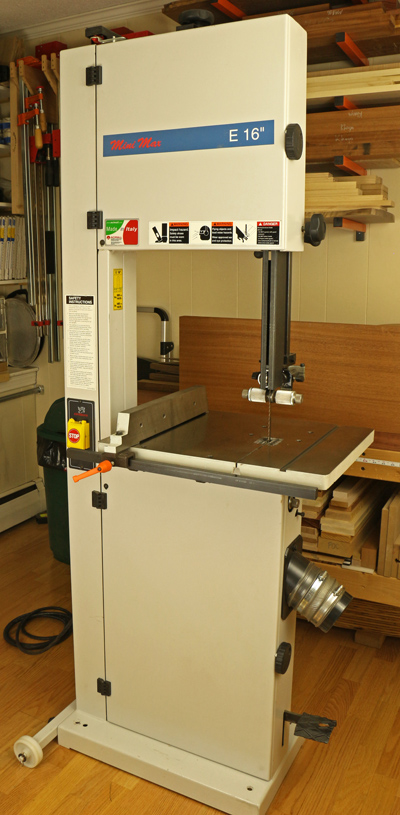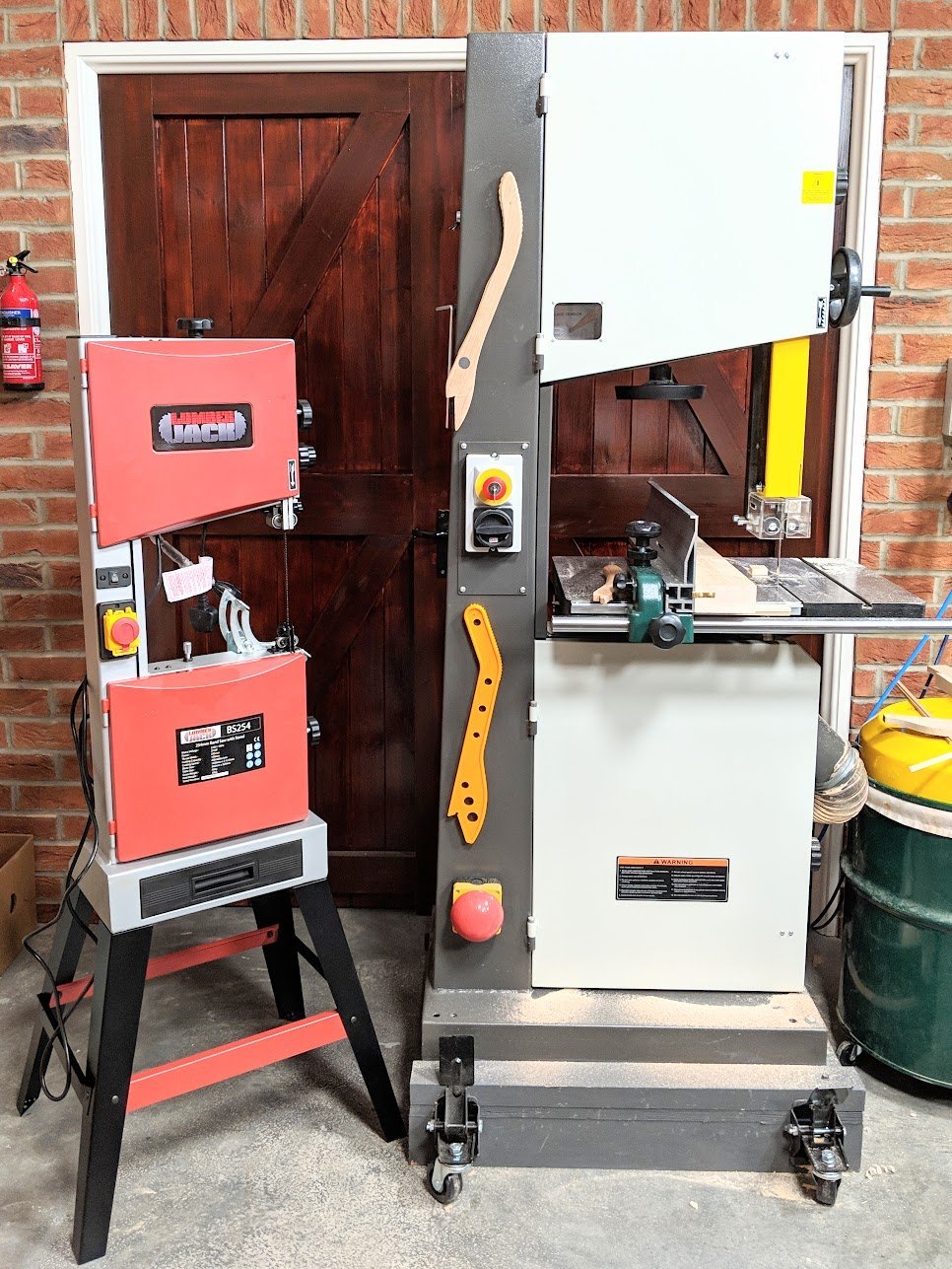Are you wondering how big a bandsaw you need for your woodworking projects? Well, you’ve come to the right place! Let’s dive into the world of bandsaws and find the perfect size for your needs.
Picture this: you’ve got a piece of wood in your hands, and you’re ready to unleash your creativity. But before you make that first cut, you need to make sure you have the right tools, starting with a bandsaw.
Now, you might be thinking, “What’s the big deal? Just get any bandsaw and call it a day.” But hold on, my friend! The size of the bandsaw you choose can make a world of difference in your woodworking journey.
So, buckle up and get ready to discover the ins and outs of finding the perfect size bandsaw for your projects, whether you’re a beginner or a seasoned woodworker. Let’s get started!

How Big a Bandsaw Do I Need? Finding the Right Size for Your Woodworking Projects
Choosing the right bandsaw size is crucial for any woodworking enthusiast. The size of a bandsaw can greatly impact the types of projects you can tackle, as well as the level of precision and efficiency you can achieve. Whether you’re a beginner or an experienced woodworker, understanding how big a bandsaw you need is essential. In this article, we’ll explore the factors to consider when determining the ideal size for your bandsaw, providing you with the knowledge to make an informed decision.
The Importance of Bandsaw Size: Accuracy, Capacity, and Versatility
When it comes to woodworking, accuracy is often paramount. The size of a bandsaw directly affects its cutting capacity and accuracy. A bandsaw with a larger throat depth and resaw capacity allows you to tackle larger projects and cut thicker materials with ease. Additionally, a larger bandsaw provides more stability and reduces the chances of blade deflection, resulting in cleaner and more precise cuts.
Moreover, the size of a bandsaw determines its versatility. A larger bandsaw can accommodate a wider range of blade widths, giving you the flexibility to make intricate cuts or rip through thick stock. On the other hand, a smaller bandsaw may be more portable and suitable for smaller projects or limited workspace. Understanding your woodworking needs and the types of projects you typically undertake will guide you in determining the right bandsaw size.
Factors to Consider When Choosing a Bandsaw Size
1. Project Size and Complexity: Consider the average size of your woodworking projects. If you mostly work on smaller pieces, a compact bandsaw with a narrower blade may suffice. However, if you frequently tackle larger projects, resawing thick stock, or cutting curves in wider material, a larger bandsaw with a wider throat depth and resaw capacity will be more suitable.
2. Available Space: Evaluate the space in your workshop or studio. Measure available floor area and height, taking into account the size of the bandsaw’s table and motor assembly. Ensure there is enough room for comfortable maneuverability and proper dust collection.
3. Frequency of Use: Consider how often you plan to use your bandsaw. If you anticipate heavy usage, investing in a larger, more robust bandsaw with higher horsepower would be beneficial. On the other hand, occasional users or hobbyists may opt for a smaller, more budget-friendly option.
Key Features and Specifications
1. Throat Depth: The throat depth refers to the distance between the blade and the vertical frame of the bandsaw. It determines the width of the stock that can be maneuvered through the cut. Measure the widest piece of material you typically work with and ensure the bandsaw’s throat depth can accommodate it.
2. Resaw Capacity: Resawing involves cutting boards into thinner veneers or planks. A bandsaw’s resaw capacity determines the maximum height of the material you can resaw. Consider the thickness of stock you’ll frequently resaw and choose a bandsaw that can handle it without strain.
3. Power and Motor: The horsepower of a bandsaw’s motor affects its cutting ability. Higher horsepower enables smoother cutting and greater accuracy, especially when working with denser and hardwoods. Evaluate the motor’s power requirements and ensure your workshop has adequate electrical capacity.
Recommended Bandsaw Sizes for Common Woodworking Projects
Now that we have explored the factors to consider when choosing a bandsaw size, let’s delve into the recommended sizes for common woodworking projects:
1. Small Projects and Hobbyists:
For small projects, such as crafting intricate decorations or making jewelry boxes, a benchtop bandsaw with a throat depth of 9-10 inches and a 1/4″ to 1/2″ blade width is generally sufficient. These compact bandsaws are portable, space-saving, and suitable for light to medium-duty work.
2. Medium-Sized Furniture and Cabinet Making:
For furniture making, cabinet installations, and general woodworking, a floor-standing bandsaw with a throat depth of 14-16 inches and a resaw capacity of 6-10 inches is recommended. These bandsaws provide the stability, power, and blade width options necessary for cutting thicker materials and making precise curved and angled cuts.
3. Resawing and Large Projects:
If you frequently work with large slabs, resaw thick boards, or undertake substantial woodworking projects, a heavy-duty bandsaw with a larger throat depth and higher resaw capacity will be essential. Consider a bandsaw with a throat depth of 18 inches or more and a resaw capacity exceeding 12 inches to tackle these demanding tasks.
Remember, these recommendations are general guidelines. Evaluate your specific project requirements, shop space, and budget when making your final decision.
Maintaining Your Bandsaw
Now that you have chosen the perfect bandsaw size for your woodworking needs, it’s essential to maintain it properly to ensure optimal performance and longevity. Here are a few tips to keep your bandsaw in top condition:
1. Blade Maintenance:
Regularly inspect and clean your bandsaw blade. Keep it sharp by using a quality blade sharpener or replacing it when necessary. Proper blade tensioning is crucial for accurate cuts, so invest in a reliable tension gauge.
2. Dust Collection:
Woodworking generates a significant amount of dust and debris. Invest in a robust dust collection system to keep your bandsaw and workshop clean. Regularly clean the table, guides, and blade area to prevent clogging and ensure smooth operation.
3. Lubrication and Alignment:
Check and lubricate the bandsaw’s moving parts, such as the wheel bearings and guides, to minimize friction. Regularly check the blade tension and tracking to ensure proper alignment and avoid drift during cuts.
By following these maintenance tips, your bandsaw will continue to perform at its best, allowing you to tackle woodworking projects with ease and precision.
In Conclusion
Choosing the right size bandsaw is crucial for any woodworking enthusiast. Consider factors such as project size, available space, and frequency of use when making your decision. Understanding the key features and specifications of a bandsaw will help you find one that best suits your needs. Additionally, proper maintenance and care will ensure your bandsaw remains in optimal working condition. Now, armed with this knowledge, go forth and tackle your woodworking projects with confidence!
Key Takeaways: How Big a Bandsaw Do I Need?
- A bandsaw size is measured by its throat or cutting capacity.
- Consider the type of projects you will be working on to determine the bandsaw size needed.
- A 14-inch bandsaw is a versatile option for most woodworking projects.
- For larger and more challenging projects, a bandsaw with a throat size of 17 inches or bigger may be necessary.
- Remember to consider the space available in your workshop before deciding on the bandsaw size.
`
Frequently Asked Questions
Choosing the right bandsaw size is crucial for any woodworking project. Here are some common questions about determining the size of a bandsaw:
`
What factors should I consider when determining the size of a bandsaw?
When choosing a bandsaw size, you need to consider the following factors:
First, think about the size of the projects you plan to work on. If you primarily work on small projects, a benchtop or small bandsaw will suffice. However, if you work on larger projects or need to resaw thick material, you’ll need a bigger bandsaw with more power.
Secondly, consider the space available in your workshop. If you have limited space, a smaller bandsaw might be more practical. On the other hand, if you have a dedicated workshop with ample space, a larger bandsaw will provide more versatility and cutting capacity.
Does the throat capacity affect the size of a bandsaw I need?
Throat capacity is an essential factor to consider when determining the size of a bandsaw you need. The throat capacity refers to the distance between the blade and the vertical frame of the bandsaw. It determines the width of the material that you can cut.
If you primarily work with smaller pieces of wood or if you have limited space, a smaller throat capacity may be sufficient. However, if you plan to work with larger pieces or need to resaw thick stock, you’ll need a bandsaw with a larger throat capacity to accommodate your needs. So, yes, throat capacity does affect the size of bandsaw you’ll need.
How does horsepower affect the size of a bandsaw I need?
The horsepower of a bandsaw motor is an important consideration when determining the size you need. More horsepower generally means more cutting capacity and the ability to handle larger and harder materials.
If you typically work with softwoods or smaller projects, a bandsaw with lower horsepower may be sufficient. However, for hardwoods or larger materials, you’ll need a bandsaw with more horsepower to efficiently cut through them. So, consider the types of materials you’ll be working with to determine the appropriate horsepower for your needs.
What are the benefits of choosing a larger bandsaw?
Choosing a larger bandsaw offers several benefits. First, a larger bandsaw provides greater cutting capacity, allowing you to work with larger and thicker materials. This is particularly useful for resawing or making deep cuts.
Additionally, larger bandsaws tend to have more powerful motors, which means they can handle tougher materials with ease. They also offer more stability, resulting in smoother and more accurate cuts. Lastly, larger bandsaws often have more advanced features and accessories, giving you more versatility in your woodworking projects.
Can I use a smaller bandsaw for larger projects by making multiple cuts?
While it is possible to use a smaller bandsaw for larger projects by making multiple cuts, it is not the most efficient or recommended approach. Making multiple cuts to achieve the desired size and shape can be time-consuming, tedious, and may result in less accurate results.
A larger bandsaw provides greater cutting capacity and power, allowing you to make the necessary cuts in fewer passes. This not only saves time but also ensures better precision. It is generally advisable to invest in a bandsaw size that matches the scale of your projects to enhance the overall efficiency and quality of your work.

Summary
Here’s what you need to remember when thinking about how big a bandsaw you need:
First, consider the size of the projects you’ll be working on. If you’re planning on cutting large pieces of lumber, you’ll need a bigger bandsaw.
Second, think about the space you have in your workshop. Make sure you choose a bandsaw that will fit comfortably in your available space.
Lastly, keep in mind your budget. Bigger bandsaws tend to be more expensive, so make sure you choose one that fits your budget.
Remember, it’s important to pick a bandsaw that meets your needs and fits within your workshop. Happy woodworking!
